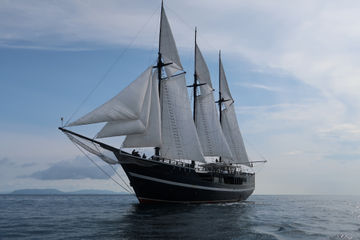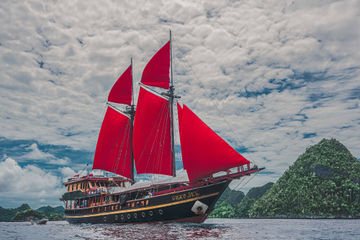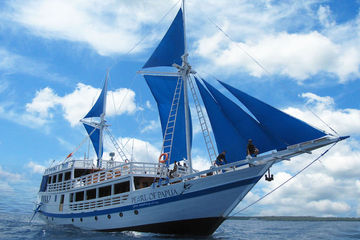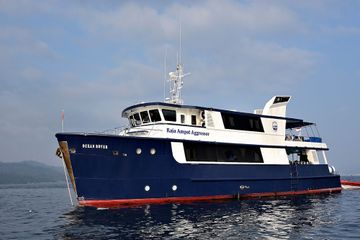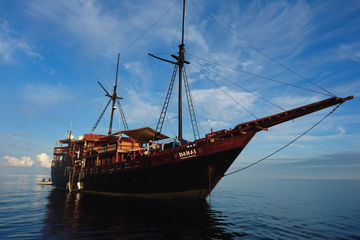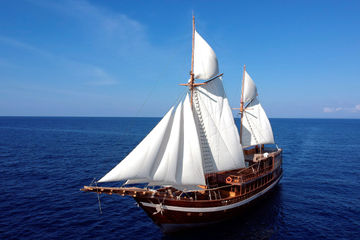Scuba diving in Cenderawasih Bay
Scuba diving in Cenderawasih Bay
Scuba diving in Cenderawasih Bay is a very unique experience, with a complete range of dive sites and an incredible number of whale sharks who frequently visit in large groups. Diving in Cenderawasih is a relatively new activity for the area, and many known dive sites have yet to be surveyed. The enchanting beauty of this sheltered bay, often as calm as a mill pond, is beginning to popularise Cendrawasih scuba diving.
In 1990, Teluk Cenderawasih National Park was designated to protect, preserve and enhance the western part of Cenderawasih Bay. The National Park covers an area of 14 535 km2, and it is the largest marine park in Indonesia. This special site of significance includes mangrove and coastal ecosystems, tropical forests, marine waters and coral reefs. Visiting Cenderawasih, you will be diving within the coral triangle, where many soft corals, as well as blue and black corals, provide shelter for juvenile fish.
11 Liveaboards in Cenderawasih BayExplore all liveaboards
Marine life in Cenderawasih
Teluk Cenderawasih National Park employs over 100 people to ensure the area, including its dive spots, are well maintained. Over 150 species of coral have been recorded as well as 200 species of fish, earning Cenderawasih the title of one of the best dive sites in Indonesia. Beautifully coloured parrotfish, shoals of damselfish, rabbitfish, pairs of butterflyfish and the rather territorial clown fish are just some of the species you will see here. Add to that several species of shark, including oceanic whitetip and blacktip reef sharks, and if youíre very lucky, scalloped hammerhead sharks. Four species of turtle are also present in Cenderawasih Bay: hawksbill, green, pacific Ridley, and leatherback. On shallower dive sites it is sometimes possible to see the incredibly endangered dugong, while further out to sea, dolphins and even the mighty blue whale can be spotted.
Best dive sites in Cenderawasih
Large numbers of whale sharks frequent Kwatisore Bay, and it is one of the few places where you can go scuba diving alongside these 40 foot (12 m), 20 tons, gentle giants. A special relationship has been formed between the local fisherman and the whale sharks. All along the bay, fisherman use floating, bamboo platforms to secure their nets. In order to protect both the whale shark and their nets, fisherman have always given away a small amount of their catch. The result is a totally unique dive site, where whale sharks are at complete ease with divers (albeit a limited number at a time). In addition, it's also possible to see Mola mola, the ocean sunfish; the heaviest known bony fish in the world.
During World War II, Cenderawasih Bay was used by the Japanese as a harbour, taking advantage of its sheltered position. WWII wrecks now lay strewn all over the bay, creating an exceptional number of dive spots. It is possible to find all sorts of WWII memorabilia including cases of grenades and ammunition, helmets, crockery, Japanese beers and wine, and even chopsticks. The locations of these wrecks have typically been recorded and charted by local fisherman, but many of them have never been dived upon before. A great deal of information is yet to be discovered and recorded into the history books. One of the wrecks includes a 390 foot (120 m) long cargo ship, the Shinwa Maru that sunk off Marsinam Island. It lies within recreational diving depths, between 50 and 110 feet (16 and 34 m), and remains largely intact. As with most wrecks here, the Shinwa Maru in now totally encrusted in soft corals, making for stunning vistas and wide angle photos. There is even a P40 Tomahawk fighter plane, where it is still possible to see the cockpit with the pilot's seat and instrumentation. These wrecks are home to many small critters, as well as large moray eels and grouper, with oceanic whitetip and blacktip reef sharks patrolling the sandy areas in between.
Best time to dive in Cenderawasih
It is possible to dive Cenderawasih Bay almost all year around; the dry season can sometimes be a little wet, while the wet season can be relatively dry. However, most diving typically takes place between the months of July and September, because many other dive sites in Indonesia are hit by strong trade winds during this time. However, Cenderawasih Bay remains sheltered, providing a fantastic alternative site to anyone wishing to go scuba diving in Indonesia, but not have to endure strong trade winds.
Experience level for diving Cenderawasih
Cenderawasih is a very sheltered bay, although strong currents are present as water is squeezed through nearby islands. It is always recommended to take an SMB along with you, including a finger spool, to ensure that all ascents are clearly marked. Divers should be around an intermediate level of experience to go scuba diving in this bay, and really enjoy to the fullest what's on offer. For anyone with a little extra time though, there are several sites where it is possible to learn to dive.
How do I get to Cenderawasih
To reach Cenderawasih Bay and embark on your dive trip, first catch a flight to Jakarta. Normally one will connect via Singapore to reach Soekarno Hatta International Airport in Jakarta. Next, fly to Sultan Hasanuddin International Airport in Ujung Pandang, before catching your final flight to Rendani Airport in Manokwari. From here, Indonesian liveaboards are able to take you scuba diving along the entirety of the bay, seeking the best spots and exploring new sites.
